Syntheses of benzothiazole amidoximes and arylimidamides and evaluation of their ADME and DNA binding properties and activity against Trypanosoma brucei
IF 6
2区 医学
Q1 CHEMISTRY, MEDICINAL
引用次数: 0
Abstract
Novel 6-amidoxime- and 6-arylimidamide-substituted benzothiazoles were synthesised to investigate their activity against Trypanosoma brucei, the causative agent of African trypanosomiasis. Benzothiazole amidoxime 12b, with diethylaminoethyl and fluorine substituents on a phenoxymethylene linker exhibited pronounced (IC50 = 0.92 μM) and selective (SI = 18) antitrypanosomal activity. ADME profiling showed that the majority of compounds synthesised are metabolically stable and that arylimidamides have low membrane permeability, while amidoximes, including 12b, have moderate to high permeability. Binding assays indicate that amidoxime 12b binds to DNA/RNA by intercalation, whereas arylimidamide 29b displays groove binding. 12b was found to be a substrate of the P-glycoprotein efflux pump, a factor that may have limited its activity in a murine model of infection, despite the other favourable properties. Structural diversification of aryl-substituted motif in amidoxime benzothiazole series will be explored to further optimize activity and ADME properties, and to overcome issues associated with low membrane permeability.

苯并噻唑类胺肟和芳酰胺类胺的合成及其对布氏锥虫的ADME和DNA结合特性和活性评价
合成了新型6-偕胺肟取代苯并噻唑和6-芳基酰胺取代苯并噻唑,研究了它们对非洲锥虫病病原体布鲁氏锥虫的活性。苯并噻唑偕胺肟12b在苯氧亚甲基连接体上具有二乙基氨基乙基和氟取代基,具有明显的(IC50 = 0.92 μM)和选择性(SI = 18)抗锥虫活性。ADME谱分析表明,合成的大多数化合物代谢稳定,芳酰胺酰胺具有低膜通透性,而酰胺肟类,包括12b,具有中高通透性。结合实验表明,偕胺肟12b通过插层与DNA/RNA结合,而芳胺酰胺29b则显示凹槽结合。12b被发现是p -糖蛋白外排泵的底物,这一因素可能限制了其在小鼠感染模型中的活性,尽管有其他有利的特性。我们将探索偕胺肟类苯并噻唑系列中芳基取代基序的结构多样化,以进一步优化活性和ADME性能,并克服低膜透性相关的问题。
本文章由计算机程序翻译,如有差异,请以英文原文为准。
求助全文
约1分钟内获得全文
求助全文
来源期刊
CiteScore
11.70
自引率
9.00%
发文量
863
审稿时长
29 days
期刊介绍:
The European Journal of Medicinal Chemistry is a global journal that publishes studies on all aspects of medicinal chemistry. It provides a medium for publication of original papers and also welcomes critical review papers.
A typical paper would report on the organic synthesis, characterization and pharmacological evaluation of compounds. Other topics of interest are drug design, QSAR, molecular modeling, drug-receptor interactions, molecular aspects of drug metabolism, prodrug synthesis and drug targeting. The journal expects manuscripts to present the rational for a study, provide insight into the design of compounds or understanding of mechanism, or clarify the targets.

 求助内容:
求助内容: 应助结果提醒方式:
应助结果提醒方式:


